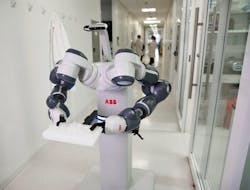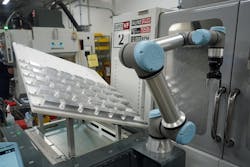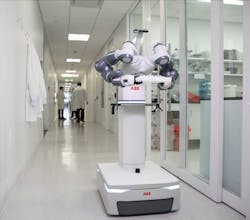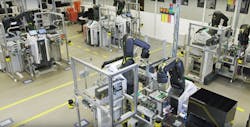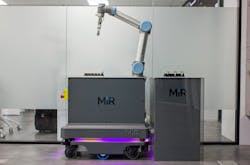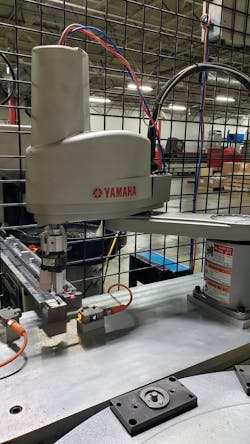Robots and automation may grow wheels, legs and arms. It’s all part of improving manufacturing. It will be required to remain competitive in many industries. A closer look at autonomous mobile robots (AMRs) and the related standards and design decisions needed to get robots moving throughout the facility shows it may not be as hard as you’d think.
Robots will become more mobile, where needed. There will be new ways they help plant-floor workers, technicians and engineers. And there are some trends in robotics that are simplifying mobile and fixed robots applications alike.
There are a variety of ways to build and control an AMR using a SCARA or articulated-arm robot mounted on an automated guided vehicle (AGV) to improve assembly, tending, logistics, inspecting and packaging applications in manufacturing. "A robotic arm mounted on a mobile platform can have many advantages over a fixed-platform robotic solution," says Matt Wicks, chief robotics solution architect at Honeywell Intelligrated in Mason, Ohio. "These mobile manipulation systems can enable the robot “arm” to roam over a wider area. This can effectively extend the reach of a robotic arm when used in conjunction with the AGV base. Think of the AGV as an extension of the robot arm, just like a person can reach farther when they lunge forward. Coupling these together can be an enabler for some applications such as automated truck unloading. A fixed robotic solution is not an option for unloading a 53-foot trailer, but it is possible with a mobile manipulation platform."
Control of a mobile manipulation system will depend on the actions and applications required. "In very simple applications, the AGV and manipulation system can be considered separately," says Wicks. "Just dispatch the AGV to take the articulated-arm robot to the location that it needs to perform a certain action, and, once it has arrived, turn over the control to the articulated arm. The positioning accuracy of the AGV systems vary, so it’s likely that computer vision and/or other tooling and docking methods will be required to enable the robot to understand its position and environment."
Robots in motion, a future conveying method
"Industrial robots with wheels will likely show up in a few years," says Samuel Alexandersson, product marketing manager at Kollmorgen AGV. "We are seeing concepts and prototypes shown at tradeshows today. Companies are working through issues around safety such as when, where and how to reach for something. For example, reaching for goods presents moment loads and concerns around center of gravity and tipping. In a lights-out warehouse, only navigation and path/picking optimization were of primary concern. In a smart factory, with people roaming around, safety is the primary concern. We think the warehouse will nevertheless lead the way in this endeavor, as it has in recent mobile robot advancements (Figure 1). Can we envision a factory of the future where a robot can tend multiple machines, even if a few meters apart? Yes. Can we envision a factory of the future with no fixed conveyors? Yes."
Figure 1: Picture this mobile bot delivering materials and tending multiple machines in the factory of the future.
(Source: Kollmorgen)
Connecting a robot arm to an AGV allows end customers to increase flexibility in their manufacturing processes. "The AGV can move between different work cells depending on demand," says Alexandersson. "It also allows end customers to go from isolated manufacturing process steps into an interconnected, fully automated factory of the future. Control of the robotic arm and AGV can be done by using one sophisticated controller. A more common solution is to integrate a motion controller for the robotic arm with an AGV controller, where commands and feedback are communicated via an industrial interface."
Mobile robot standards
"Autonomous mobile robots are the latest innovation that have been transforming traditional robot tasks through increased flexibility and diversified applications," says Bob Doyle, vice president, marketing, communications & advocacy, Association for Advancing Automation (A3) in Ann Arbor, Michigan. “AMRs are known for their unique ability to navigate in an uncontrolled environment with a higher level of understanding via sensors, blueprints, artificial intelligence and 3D or 2D vision. Their perception allows these robots to reroute automatically when something is in the way. AMRs are highly innovative compared to a traditional AGV, which is also mobile but uses wires or magnets to navigate a narrowly defined area from Point A to Point B."
The next step of the AMR is mounting an arm on a mobile base, so that it can start an operation at Point A to manipulate and actually move autonomously to Point B in an operation.
"The future of automation contains a fundamental shift: the reduction of barriers between the robot and its environment," says Doyle. "Integrators should already be cognizant of the Robotic Industries Association (RIA) R15.06 American National Standard for Industrial Robot Safety Standard, addressing hazards in an industrial environment where the robot is bolted in place with fencing around the hazard zone."
Now, the industry is full of collaborative robots working in tandem with a person while the barriers are removed, and autonomous mobile robots are adding another layer of complexity to safety considerations, continues Doyle. "The RIA is introducing a new standard to address all aspects related to the safety of people around AMRs: the R15.08 American National Standard for Industrial Mobile Robots and Robot Systems—Safety Requirements," he says.
The new standard is designed to address these considerations for manufacturers, integrators and end users. The standard describes basic hazards associated with AMRs in an industrial environment, and provides requirements to eliminate or adequately reduce the risks associated with these dangers.
Challenges of added motion
"While simply adding a SCARA or six-axis robot on top of an AGV or AMR can be done pretty easily, many challenges exist once you do so, and there are many important considerations to not gloss over," says Scott Marsic, product manager for Epson Robots. To look at a few considerations, one must start with power. "Industrial robots are typically plugged in so they can run 24/7. AMRs and AGVs are by their nature remote devices. As such, they are kind of like forklifts and need to be charged periodically or powered remotely."
Once you've solved the power issue, you face the challenge of making the remote device do the tasks you want it to do, continues Marsic. "For example, in a warehouse environment you’ll need to be able to easily find your way around to find a part bin," he says. "This requires the mapping of your environment and writing some software to do this. Once I’m there, how do I find a specific part? Vision is required, and this must be integrated into the remote system. Next, how do I grab the parts? Gripper integration is critical here, but, if I am in a warehouse environment with hundreds or thousands of parts, using one generic gripper might be inadequate."
These AMRs will need to do various things. "The bottom line is AGVs and AMRs are exciting growth areas for automation, but it’s important to consider in advance the full system," says Marsic. "How do all the components integrate together such that the implementation, control and management of a remote device is both possible and adaptable to environment changes?" he asks. “There will be many considerations, and this is just looking at warehouse environments."
Warehousing end users seemed to be the leaders in AGV type robots, whether they run on the floors or even the ceilings, says Chris Elston, chief robotics manager at YRG in Fort Wayne, Indiana, a master distributor of Yamaha Robots. "The concept of standard industrial robots as we know them today have been looked at numerous times to make them mobile, but the power requirements continue to challenge machine builders and system integrators," he says. "Most industrial robots require ac power to operate them at faster cycle speeds, so this limits their use on an AGV. Robots that are mounted on AGVs have to be redesigned with lower power requirements or even accept dc electrical power. These are not requests that are being overlooked, just not readily available right now with standard cataloged robots."
Mechanically and electrically, it is important to make sure that the robot arm is compatible with the mobile robot on which it is mounted, says Nicolas Lauzier, vice president of engineering at Robotiq. "There are often combinations offered on the market which can simplify the selection," he says (Figure 2).
Figure 2: Add a camera and mobility to this Universal Robots' cobot with Robotiq adaptive gripper, and this robot will be tending multiple CNC machines.
(Source: Robotiq)
The mobile robots are usually programmed by moving them around the factory using a remote control. The onboard sensors then map the factory, and the robot is later able to orient itself autonomously. The scanned map can be adjusted on a PC in order to add restricted zones, virtual obstacles and targets for doing its tasks.
"These mobile robots are usually precise to a few centimeters, which is not enough for most applications,” says Lauzier. "One good way to cope with this missing accuracy is to use some tags mounted on the machines or stations, which can be located precisely by a camera mounted on the robot arm. With this approach, it is possible for the mobile robot to move next to the station, stop, have the camera precisely locate the tag and have the robot arm work as precisely as if it has been at this exact position when first programmed."
Control and positioning
"From my experience the controls have been discrete at this point for the fleet management of the mobility portion and the existing OEM robot control for the arm," says Micah Troxler, mobility product manager at ABB Robotics. "It is typically a PLC interface, and no single controller for both mobility and the arm have been widely established yet. Most of the mobile manipulators currently on the market follow a multi-controller strategy. The manipulator is triggered by a signal (IPC/PLC) from the AGV when the AGV confirms to have reached the designated destination to execute Task XYZ."
Because, typically, the positioning accuracy of the AGV is not sufficient enough, or is too expensive time-wise, for a manipulator to execute its tasks, an integrated vision system is needed, continues Troxler. "Combining all these different control systems, including AGV, safety, robot control, robot vision and optional additional axis and AGV guiding called simultaneous localization and mapping (SLAM), is difficult but likely to be achieved in the future."
Control is only one of several aspects of mobile manipulation. "From a regulatory perspective there is nothing in place, and the industry follows the rule that an AGV must stand still while the mobile manipulator is moved, and the manipulator must be still while the AGV is moving," says Troxler. "Power demand, current peaks, especially of fast and/or heavy manipulators does not fit a classical battery performance and needs to be bypassed, as well. Robot control on a mobile base is both art and science. Before you worry about control, you have to address the power requirements and ensure the combined technologies have a reasonable operational time between charging needs."
Fortunately, much has already developed for the machine builder, integrator and end users of AMRs. "One of the biggest trends in robotics has been advances that make robots easier and less expensive to implement and maintain," says Mark Handelsman, U.S. channel sales manager at ABB Robotics. "Within the past several years collaborative robot solutions have grown from a few early adaptors to a major portion of the robot market. This includes robots designed for collaborative operations such as ABB’s YuMi single- and dual-arm robots, as well as scanners and other safety devices that monitor the work area in conjunction with robot safety controls such as ABB’s SafeMove2 (Figure 3). This trend both reduces the integration costs and eliminates feeders and indexers by allowing operators to safely work within the robot work envelope."
Figure 3: ABB's mobile and autonomous YuMi laboratory robot concept will be designed to work alongside medical staff and lab workers.
(Source: ABB)
Getting a robot in motion
Less is better when adding mobility to a robot. "Last year we introduced what we call our next-generation solution, which is a truly integrated machine controller versus the traditional machine/PLC controller with a separate, stand-alone robot controller," says Craig A. Souser, president/CEO of J.L. Souser & Associates (JLS), in York, Pennsylvania. "An integrated machine controller, beyond eliminating a number of pieces of hardware by combining the machine and robot controller into a single controller, eliminates some critical communication requirements as everything is now in one machine, and the system overall is much simpler. The electrical footprint reduction is dramatic. This is a pretty common approach for companies in Europe, but JLS is one of the few to offer this in the United States. We selected B&R as our platform."
Others are combining the mobility and robot control, as well. "By taking a holistic approach on the assembly process, we are able to combine these technologies using known technology from the SCARA/articulated arm with the ever-improving guidance of AGV location," says Chris Lupfer, sales manager assembly technology at Bosch Rexroth. "The result is the ability to provide a complete system that customers can easily build themselves and then use in their assembly operations. At Rexroth, we have done this with our APAS robot mounted on an AGV, and we are using it in Bosch manufacturing facilities (Figure 4)."
Figure 4: Bosch-Rexroth combines known technology from its articulated arm APAS robots with an AGV and uses it in its manufacturing facilities.
(Source: Bosch-Rexroth)
Mounting a collaborative robot on an autonomous guided robot (AGR) or AMR platform is straightforward, according to Joe Campbell, senior manager of applications development, Universal Robots. "Universal Robots' cobots are lightweight and are not power hungry, making them ideal for mobile applications," he says. "New controller configurations allow mounting within the AMR platform, and the collaborative technology ensures safe operation in multiple locations (Figure 5)."
Figure 5: Universal Robots' cobots are lightweight and are not power hungry, making them ideal for mobile applications.
(Source: Universal Robots)
Unlike traditional robots, collaborative are a perfect match for AGV or AMR mounting, continues Campbell. "Control is simple, as robot motions and AMR motions would not overlap, and simple communications between the two devices can be established in multiple protocols," he says. "It is also worth noting that this is an extension of a very simple concept that is gaining favor throughout low-volume/high-mix manufacturing: cobot-as-a-tool. Collaborative robots mounted to manually powered carts allow the cobot to be moved from machine to machine, station to station, depending on the production mix for the day."
Robots playing together
"Integrators should know the AMR’s easy programming and implementation make them even more attractive to end users, and most AMRs are at peak production when combined with another traditional robot system," says Bob Doyle at A3. "Something to keep in mind, however, is understanding AMR companies can go straight to market without an integrator. Providing solutions for using AMRs with traditional systems will give integrators the competitive edge."
Two examples of AMRs in action include the Honeywell General Merchandise Truck Unloader and the Mobile Industrial Robots MiR1000. The Truck Unloader is a flexible piece of machinery that can unload a variety of shapes, sizes or multi-weighted products from a truck container using machine vision and sensors to decide how to best complete the task. The MiR1000 replaces the forklift, designed to withstand a payload of 1,000 kg and equipped with six laser scanners, 3D cameras and an artificial intelligence camera.
"Incorporating cutting-edge technology, AMRs like these can allow companies to reduce the work in manufacturing and make more on-time deliveries,” says Doyle. "Hybrid solutions incorporating traditional systems and AMRs working together are optimal. The truck-unloading AMR interfaces with a traditional fixed automated palletizer or conveyance system, leading the product further on its journey with complete automation. The robots enhance each other and increase efficiency and can even maximize floor space, allowing for system integrators to work more machines into solutions; all of this can move product through processing at a faster pace."
It’s no longer enough to transport material from Point A to Point B; the most valuable AMRs incorporate a data-driven strategy," continues Doyle. "Traditional fulfillment centers use a person to pull inventory and bring it to a pick-and-pack station, which is done off-line with no understanding of flow-path optimization. Today’s AMRs are creating a digital understanding of end-to-end movement. AMRs are building aggregate data across the entire organization to create a common data architecture that understands the movement pattern of materials, how to improve and how to reconfigure and simulate optimizations."
So far, system integrators can look for AMR incorporation in unloading trailers, fleet management in warehouses, conveyor systems, manufacturing work cells, hospitals, aerospace, semiconductors, automotive and logistics.
Figure: Often, robot mobility is not needed as this simple Yamaha SCARA can do a lot of work simply and quickly.
(Source: YRG)
Welcoming robots to the plant floor
You have to crawl before you walk. "There are still a lot of end users getting their hands on a robot for the first time, and not yet ready for AGVs or robots with legs," says Chris Elston at YRG, a master distributor of Yamaha Robots. "Many older manufacturing companies in North America are re-learning automation with many companies who are reshoring production back to the United States after years of manual production overseas. Manufacturing engineers are struggling with choices of which robot to deploy, such as a cobot verses a tradition industrial robot, and in a lot of cases cobots have been misapplied. North American automation, robotics and AGV uses continue to lag, compared to Asian type companies, for example. Exceptions are tech companies or online retailers who are finding faster and better ways to use AGVs and robotics, but a bulk of manufacturing in North America is still that company in Small Town, USA, that has been in business for 50-plus years, combatting finding employees and maintaining the labor workforce."
Recently, General Plug & Manufacturing from Oberlin, Ohio, looked at automating a plug process. A collaborative robot was looked at first, but the desired cycle rate of 2.5 seconds per piece was too demanding for a cobot, so a traditional SCARA was considered. Three weeks after installing its first Yamaha SCARA robot, a sustained 2.25-second cycle time with a much higher uptime and runtime has been averaging more than 1,600 pieces per hour with automation, versus 1,400 pieces per hour before automation.
“I had instructions to look into automation and was invited to a demo for a collaborative robot from a local distributor and shared findings with the owner about a guided robot vision application," says Ernie Campbell, sealant manager at General Plug & Manufacturing. "I was quite impressed with the collaborative robots but didn’t see an application for it, so I got into a discussion with the same distributor, which led to Glen Morr, Yamaha application engineer, bringing a sales gurney out and showing us a Yamaha SCARA robot, and the proverbial light bulb went off. After additional research we bought two for our assembly process.”
ALSO READ: The future direction of control
About the Author

Dave Perkon
Technical Editor
Dave Perkon is contributing editor for Control Design. He has engineered and managed automation projects for Fortune 500 companies in the medical, automotive, semiconductor, defense and solar industries.

Leaders relevant to this article:
